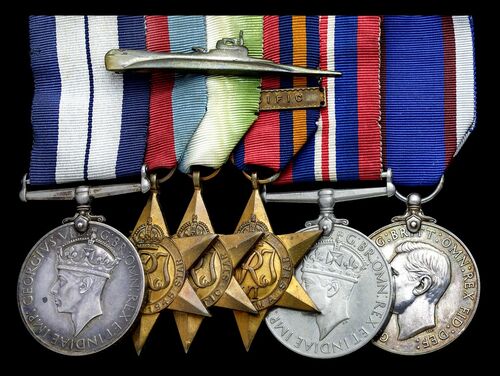Auction: 24002 - Orders, Decorations and Medals
Lot: 186
(x) Family group:
An unusual Second World War submariner's D.S.M. group of six awarded to Chief Electrical Artificer E. W. Wardell, Royal Navy, who was decorated for his gallant deeds in H.M.S. Graph - previously the German U-570 - when, in what might be deemed a cannibalistic act, she attacked another U-boat in the Bay of Biscay
Distinguished Service Medal, G.VI.R. (MX. 51828 E. W. Wardell, Elect. Art. R.N.); 1939-45 Star; Atlantic Star; Burma Star, clasp, Pacific; War Medal 1939-45; Royal Fleet Reserve L.S. & G.C., G.VI.R., 2nd issue (MX. 51828 E. W. Wardell, D.S.M., Po. B 22328 C.E.A. R.F.R.), excepting the last, mounted as worn, together with a submarine sweetheart brooch and a pair of miniature presentation oars for Artificer Gig competitions in 1937 and 1938, silver, with Birmingham hallmarks for the same year, generally good very fine
The Great War campaign pair awarded Aircraftman 1st Grade W. E. Wardell, Royal Naval Air Service
British War and Victory Medals (F. 17196 W. E. Wardell, A.C. 1, R.N.A.S.), mounted as worn, generally good very fine (8)
D.S.M. London Gazette 5 January 1943: 'For great courage, skill and determination in a successful submarine patrol.'
Edgar Wiliam Wardell was born on 13 July 1913, the son of William and Violet Wardell; his father would witness active service in the Royal Naval Air Service in the Great War. Come the renewal of hostilities, Edgar too opted for naval service, but in his case by volunteering for submarines.
'His Majesty's U-Boat'
Hence his joining H.M.S. Graph, a unique commission of the Royal Navy, for she had previously operated under the swastika as U-570. Thanks, however, to the sharp eyes and actions of Squadron Leader James Thompson, a Hudson pilot of No. 269 Squadron, not to mention several ships of the Royal Navy, the U-boat was intercepted and captured in August 1941.
Duly converted and re-christened by the Admiralty as H.M.S. Graph - also jokingly known as 'H.M. U-Boat' - she joined the Third Submarine Flotilla under Lieutenant-Commander P. B. Marriot, R.N. and a specialist crew. Nonetheless, she was still internally very different from anything previously experienced by British submariners, and her crew never really became accustomed to the slogan painted below decks: 'The Fuehrer Leads and We Follow.'
On Trafalgar Day 1942 during her first war patrol, Graph dived to avoid a German Condor long-range patrol aircraft in a position about 50 nautical miles off Cape Ortegal, Spain. In so doing, Marriott picked up a loud hydrophone contact and, 12 minutes later, he sighted a U-boat, its conning tower clearly visible against the setting sun. He ordered a four-torpedo attack and when explosions were heard a few minutes later, he and his crew assumed they had found their mark. The Admiralty clearly agreed, for he and several members of his crew - Wardell included - were decorated; post-war investigation confirmed his target - the U-333 - had in fact escaped, and that Graph's torpedoes had likely self-detonated.
Departing the Clyde on her third war patrol on Christmas Eve 1942, Graph sailed northwards in the company of her consorts Seadog, Trespasser and Unruly, and the Dutch submarine 014, their allotted task to watch over the Tirpitz and other German ships in the Norwegian fjords. At 1 a.m. on New Year's Day, Graph sighted the heavy cruiser Admiral Hipper, a tantalising target who escaped her clutches on account of her superior speed. But just over three hours later, she encountered two enemy destroyers moving erratically and at relatively low speed. Closing the range to around 7,000 yards - and having entered the appropriate data in his 'fruit machine' - Marriott fired a pattern of four-torpedoes, seemingly with some success; post-war investigation, however, established otherwise.
In March 1943, largely at Churchill's behest - "We own a U-boat. Let's make the most of it" - Graph was ordered to Londonderry where she undertook training duties for destroyer and corvette crews in anti-U-boat tactics. Moreover, she was used to acquaint potential boarding parties with the layout of a U-boat. However, she was badly damaged on journeying to Chatham for a refit at the year's end and ended up being grounded and wrecked off the Isle of Islay.
Sadly, Edgar's younger brother Alan, also an Electrical Artificer, was killed off North Africa in November 1942 when the Hecla was torpedoed during Operation 'Torch'. Edgar, who received his D.S.M. at a Buckingham Palace investiture in February 1943, retired to Surrey, where he died in October 1981; sold with a quantity of newspaper cuttings, including one reporting his brother as 'missing'.
William Edward Wardell - Edgar's father - was born in Sydenham, Kent on 19 July 1880 and joined the Royal Naval Air Service as an Aircraftman 2nd Grade in July 1916. Quickly embarked for the Imbros in the Aegean, near the entrance to the Dardanelles, he remained employed there until retuning to the U.K. in early 1918; his service record is endorsed for 'Land Operations' in 1916-17.
Subject to 5% tax on Hammer Price in addition to 20% VAT on Buyer’s Premium.
Sold for
£1,400
Starting price
£800







